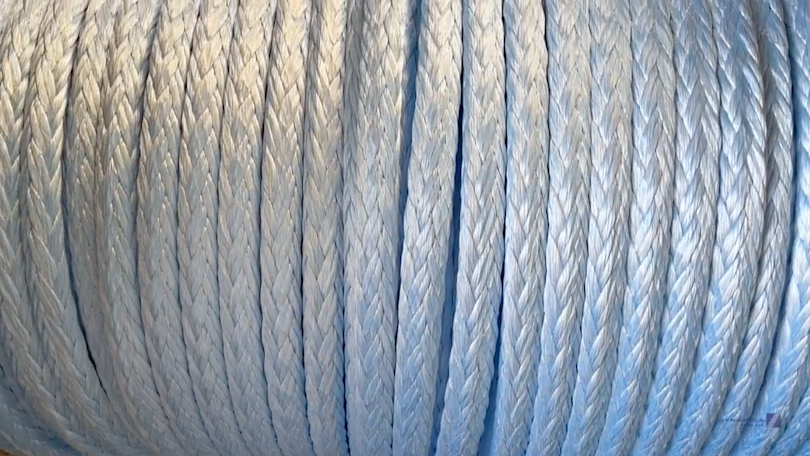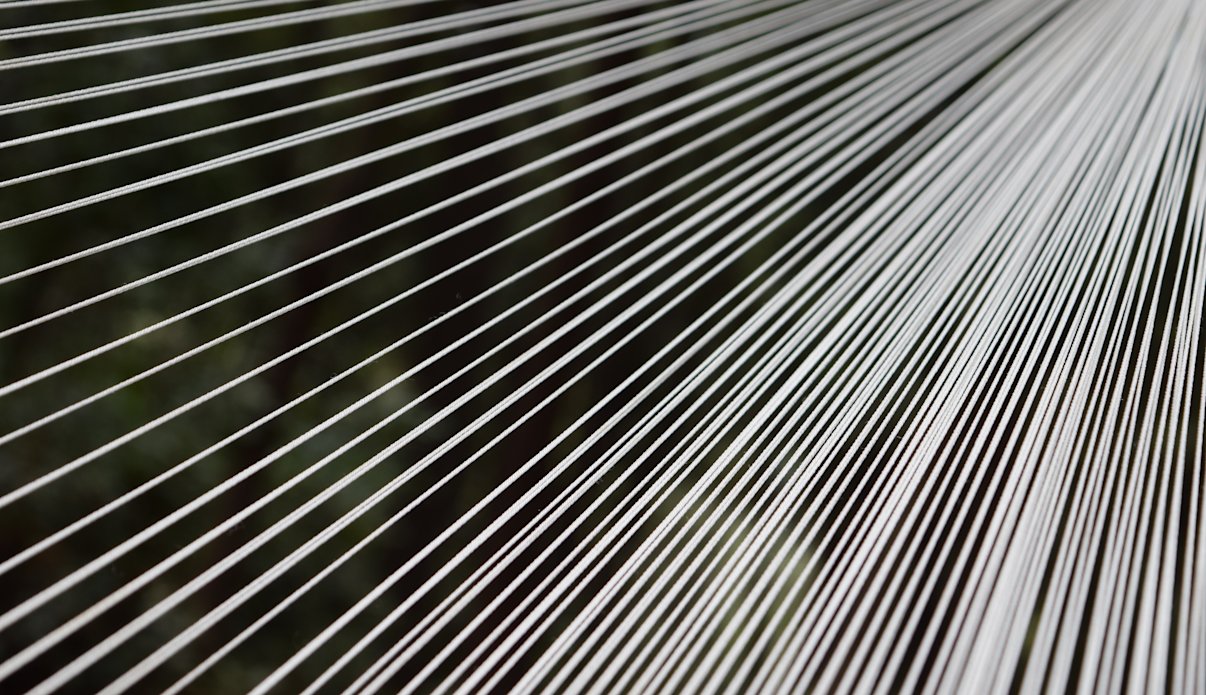- Dynamica Ropes
- Dyneema® ropes
Ropes made with HMPE or Dyneema® are stronger than steel wire
Many users ask “What is HMPE or Dyneema® and what is Dyneema® rope”? The short answer is that Dyneema® is the world´s strongest fiber™.
Dyneema® offers exceptional strength-to-weight ratio, being up to 15 times stronger than steel by weight, while also being lightweight, durable, and resistant to humid conditions, chemicals, and UV rays.
Dyneema® is also called ultra-high molecular weight polyethylene (UHMWPE), used for manufacturing several types of ropes, slings and tethers. Its many benefits make Dyneema® ropes ideal for demanding applications such as marine, industrial, and outdoor uses where high performance and reliability are required.

You can find our high-quality products made with Dyneema® in industries such as heavy lifting, on- & offshore wind, FOWT, oil & gas, maritime, subsea, defence, winch, vehicle recovery 4x4, aquaculture & fishing and a few more. At Dynamica Ropes, we manufacture our rope solutions with HMPE or Dyneema® in order to offer you the lightest, strongest and most reliable solution possible.
In fact, our rope solutions have such high strength performance, that they are replacing steel wire and chains for heavy lifting operations both on- and offshore.
Our HMPE or Dyneema® product range
At Dynamica Ropes, all of our products are constructed as 12-strand braid or parallel fibres, but they vary in construction, cores and covers. Below you can see our standard products:
| SecureLift Slings | Ultra-light and strong fibre round slings made with HMPE/Dyneema® replacing steel wire for heavy lifting operations on- & offshore. |
| SafeLift Slings | Dyneema/HMPE rope slings |
| Tethers | Subsea/Deepsea fibre & rope Tethers |
| Mooring & Towing ropes | Abrasion & UV resistant ropes |
| Winch ropes | Winch ropes for 4x4, gliders, lashings, taglines, helicopters & j-tube |
| Ropes | A variety of ropes made with the worlds strongest man-made fibre |
For most applications, we produce the products with HMPE or Dyneema® fibres SK75 and SK78. On request, we produce ropes with SK99, DM20 fibres and with XBO treatment.
SK75 and SK78 outperform all the other HMPE fibres in measured strength, ensuring a stable performance in your rope. Moreover, the creep lifetime under equal load and temperature is much longer. SK78 has lower creep than SK75, making it the preferred choice for static applications.
Production of Dyneema® Ropes
Come backstage to the Dynamica Ropes production department and see how we produce the strongest ropes, slings and tether solutions to match your needs and expectations.

The correct Dyneema® Rope solution is value for money
When choosing your rope solution, sling or tether, it is important to consider:
Material: SK75, SK 78, SK99, DM20, HMPE
Construction: 12-braid, core
Cover material: 12-braid, 24-braid, 32-braid
Coating: PU, LAGO, XBO, stiffness/flexibility, color
Minimum breaking load (MBL) / working load limit (WLL)
Length / effective working length (EWL)
Termination: Soft eye, thimble eye
At Dynamica Ropes, we assist you in choosing the correct solution for specifically your operation – everything from material to cover.
We offer great know-how whenever you need assistance as our R&D team have several years’ experience in designing and manufacturing rope solutions, lifting slings and tethers made with HMPE/Dyneema®.
Types of synthetic fibres
There are many different synthetic fibres besides HMPE and Dyneema® e.g.:
Aramids (Kevlar)
Vectran
Nylon
Polypropylene
Polyethylene (Dyneema® & Spectra)
HMPE and Dyneema® fibre is superior to the above mentioned fibres in terms of:
Weight basis
Abrasion resistance
Fatigue resistance
Fungal resistance
UV stability
Resistance to chemical substances
Positive Buoyancy
Dyneema® rope do's
When choosing ropes, slings or tethers with HMPE or Dyneema® there are a few important factors to be aware of as this can influence the lifespan of your equipment:

UV resistance

Chemical resistance

Creep
Want to know more about Dyneema®? Download the guidelines here:
Dyneema® rope don'ts
When choosing ropes, slings or tethers with HMPE or Dyneema® there are some clear don’ts.
Do not tie knots! Introducing knots to rope will cause up to 60 % loss in strength of the rope. Instead, opt for splices. When executed by trained and authorised riggers, you will only lose about 10 % of the initial strength.
Our riggers have performed thousands of splices. They are educated to handle unique and custom-made products to ensure a uniform and premium manufacturing process.
FAQ about Dyneema® Ropes
What is Dyneema®, and how is it different from other ropes?
Dyneema® is a brand of ultra-high-molecular-weight polyethylene (UHMWPE) known for its exceptional strength-to-weight ratio. It is significantly lighter and stronger than traditional rope materials like nylon and polyester. Additionally, it offers excellent resistance to abrasion, chemicals, and moisture.
How strong are Dyneema® ropes compared to other materials?
Dyneema® ropes have up to 10 times the strength of steel on a weight-for-weight basis and are significantly stronger than nylon or polyester ropes. This makes them ideal for demanding applications where high strength is required.
What are the main applications for Dyneema® ropes?
Dyneema® ropes are used in a variety of applications, including sailing,rigging,mooring , commercial fishing (nets and ropes), industrial lifting, offshore energy (towlines, moorings and slings), and even recreational sports like climbing and paragliding.
Is Dyneema® rope UV-resistant?
Yes, Dyneema® rope is highly UV-resistant and can endure long-term exposure to sunlight without significant degradation, making it ideal for outdoor and marine use.
Is Dyneema® rope waterproof or resistant to water absorption?
Dyneema® is waterproof and has a negligible water absorption rate. It retains its strength even when wet, making it perfect for marine and outdoor environments, also in very cold weather conditions.
Is Dyneema® rope heat-resistant?
While Dyneema® has good thermal stability at moderate temperatures, it has a relatively low melting point (about 135°C or 275°F). Prolonged exposure to high temperatures or friction can weaken it, so caution is needed in high-heat applications.
Can Dyneema® rope float on water?
Yes, Dyneema® ropes are buoyant and float on water, a feature that adds to their suitability for marine and aquatic applications. The specific gravity of Dyneema® is 0,97.
How durable is Dyneema® in harsh conditions?
Dyneema® performs exceptionally well in harsh environments. It resists saltwater corrosion, extreme cold, and abrasive conditions, maintaining its strength and flexibility even in demanding settings.
Can Dyneema® rope be spliced?
Yes, Dyneema® ropes can be spliced effectively. Splicing is the preferred method of joining or terminating Dyneema® because it maintains most of the rope's strength compared to knots.
How does Dyneema® rope perform under load and dynamic stress?
Dyneema® ropes have very low elongation (app than 3,5% at break), making them highly efficient under static and dynamic loads. They are ideal for applications requiring minimal stretch and high load capacity.
How does Dyneema® compare in weight to other ropes?
Dyneema® ropes are incredibly lightweight—7 to 10 times lighter than steel ropes of equivalent strength. This makes them a preferred choice in applications where reducing weight is critical.
What is the expected lifespan of Dyneema® rope?
The lifespan of Dyneema® ropes depends on the application and exposure to environmental factors, but they typically last much longer than ropes made from other materials due to their resistance to wear and environmental degradation.
How do you properly maintain and care for Dyneema® rope?
To maintain Dyneema® ropes, clean them with fresh water after exposure to saltwater or dirt, store them in a dry, shaded area, and avoid prolonged exposure to high heat or sharp edges that could cause cuts.
What is the cost of Dyneema® rope compared to other solutions?
Dyneema® ropes are more expensive than nylon or polyester ropes. However, their superior strength, durability, and lightweight characteristics often justify the higher cost, especially in professional applications.
What are the limitations of Dyneema® rope?
Limitations of Dyneema® include its lower resistance to high temperatures and susceptibility to cutting or damage from sharp objects due to its relatively low surface hardness.

